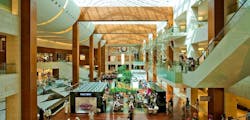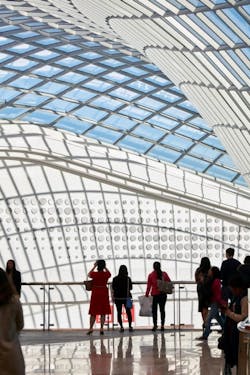Light is the theme: The mall yesterday and today
Natural light and its interplay with materials, as eloquently described in Louis Kahn’s book, “Light is the Theme,” was the primary driver behind Kahn’s brilliant design for the Kimbell Art Museum. The same is often true of shopping malls.
Take, for example, Galleria Vittorio Emanuele II in Milan, which is as much a monument as it is a mall. As the oldest shopping center in the world that remains in business to this day, its legacy and role as a local landmark make the historic five-story structure one of the most inspiring architectural examples in our industry. Galleria Vittorio Emanuele II owes its success to a combination of factors: its majestic aesthetic and its location between Piazza del Duomo and Piazza del Scala endows it with a certain importance, and the upscale brand names housed within are a draw for both locals and tourists. But as Guy Martin wrote in a 2015 article for Forbes, the building is also notable thanks to one particular architectural feature:
“The soaring thousand-yard-long glass roof is, even today, a technical marvel. It’s the cerulean blue light streaming through the glass in the early evening – blue no matter what the weather – that gives the stroller the celestial pause. The light illuminates the trade. It makes you want to buy a fine new hat, a handmade Fratelli Prada valise, a great cigar, and stroll down to the Restaurant Biffi, which has also been in these halls since the late 1860s, when the Galleria had not yet been fully completed, and order one of their big fine old grappas.”
The light illuminates the trade—but it also does many other things. I remember hearing Frank Taliaferro, the “T” in RTKL, talk about the origin of skylights in shopping centers. The earliest American malls didn’t offer much in the way of natural light; the big selling points were plenty of free parking and air conditioning throughout, and light just made it harder to keep things cool. But eventually, as Frank noted, we began introducing plant material into the mall, which naturally required another key component: sunlight. And before we knew it, big, barrel-vaulted skylights became synonymous with the idea of a shopping arcade, and malls everywhere began to emulate Galleria Vittorio Emanuele II.
Increased awareness around the benefits of natural light in a retail environment has solidified the skylight’s central place in shopping center design and given us the data to back up this approach. The indoor-outdoor connection has tangible value attached to it, documented by numerous studies dating back to the 1990s. One of the more in-depth investigations into the impact of natural light in a shopping environment involved a two-year analysis, from 1999-2001, of a chain of 73 retail stores in California. The results demonstrated a 40% increase in gross sales following installation of skylights—a profit increase that was 19 times greater than the energy savings (the study is detailed in the 2015 report, “The Economics of Biophilia.”)
A wide range of disciplines—psychological, environmental, economic—continues to confirm natural light’s positive impact on our surroundings. Simply put, natural light makes us feel better, physically, emotionally and mentally, and that makes us more likely to stay in a place longer and, quite frankly, to spend more money while we’re there.
As the benefits of natural light have become more apparent and are documented in more detail, advanced technology and construction techniques have allowed architects to execute ever more innovative, and sustainable, skylight designs. Twenty-five years ago, skylights relied upon a mirrored external surface to reduce heat gain but were tinted on the inside for energy efficiency; now, modern glazing systems have evolved to the point where skylights can appear transparent and still offer all the necessary light-diffusing qualities that keep heat out but let unfiltered light in.
Other examples include responsive skylights, featuring advanced glazing that changes the tint in response to environmental conditions, and photovoltaic glass (PV) that can turn light into energy. We even have LED “media glass” that appears completely transparent while offering a grand canvas for displaying art, branding, light and color. The possibilities are endless. Meanwhile, the efficacy of passive design techniques, like proper siting to maximize daylight exposure, continues to support the usage of skylights to ensure light reaches deep into the building.
As a result, skylight design keeps getting more expressive. In April 2016, the Fulton Center and Sky Reflector Net in New York—designed by James Carpenter Design Associates, a CRTKL partner and collaborator on two current projects—won the International Association of Lighting Designers Award of Merit with its 15-meter-diameter skylight oculus that brings daylight into the space by way of a slight tilt toward the building’s southern exposure.
Six months later, one of CallisonRTKL’s flagship projects, Chadstone Shopping Centre in Melbourne, Australia, became an Instagram star upon the grand opening of its latest expansion thanks to a parametrically designed, organically formed skylight that spans up to 42 meters, covers an area of approximately 7,000 square meters and is only 210 millimeters thick. It’s the largest grid shell roof in the world, and the first in Australia. Yet cutting-edge technology and design isn’t the only way for skylights to stand out: their architectural integrity can be locally influenced, like the skylight for the CallisonRTKL-designed Yas Mall in Abu Dhabi, which features a contemporary pattern inspired by Emirati culture and heritage.
Overall, these examples teach us that there are two key qualities of good skylight design: purity and placemaking. And when those factors are at the heart of our efforts to shed light on the shopping mall, the results can be illuminating in more ways than one.



